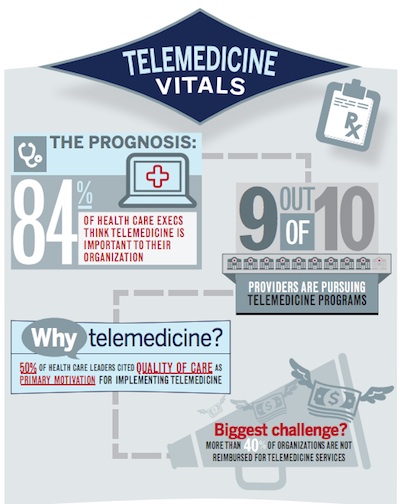 A survey by the law firm Foley & Lardner LLP of 57 executives at provider organizations found a healthy interest in telemedicine, but that concrete adoption is still in the early stages, and possibly more than a decade away.
A survey by the law firm Foley & Lardner LLP of 57 executives at provider organizations found a healthy interest in telemedicine, but that concrete adoption is still in the early stages, and possibly more than a decade away.
Only 3 percent of respondents considered telemedicine unimportant to their organizations. Fifty-two percent found it very important and 32 percent said it was important to their organizations.
Yet only 6 percent of respondents had "mature" telemedicine services in place. The majority had programs in some phase of development: 34 percent said the programs were "under consideration" or in development, 18 percent were in the optimization phase, 16 percent were being piloted and 18 percent were being implemented. Just 8 percent of respondents said they had no program at all.
In regards to particular technologies, 64 percent said they offered remote monitoring, 54 percent reported using store and forward technology, and 52 percent had some kind of real-time interaction technology such as video visits. Another 39 percent had mobile health offerings like patient-engagement apps and online portals.
The survey also dug into executives' reasons for pursuing telemedicine. Interestingly, their motivation was not -- at least in the short term -- economic. Only 11 percent said "the potential for increased revenue/profitability" was a top reason, and only 4 percent were motivated by "getting a jump on the competition." Instead, the leading response was that executives were primarily motivated by the idea of improving quality of care for patients (50 percent) or reaching new patients (18 percent).
Adding more support to the idea that it's not all about the money, 48 percent of executives said their biggest concern in convincing doctors to adopt the technology was convincing them that the technology works, whereas just 36 percent were most concerned with convincing doctors they'd be adequately compensated.
Maybe that's partially because that compensation is still a ways away for many. Forty-one percent of respondents said they weren't reimbursed at all for telemedicine service, and another 21 percent was reimbursed, but at a lower rate than they would have gotten for the same services in person.
Finally, executives were asked to predict what percentage of their patients would be benefitting from telemedicine in 10 years. Only 11 percent thought 50 percent or more of patients would be using telemedicine services. Sixty-four percent thought between 10 and 50 percent would be using telemedicine, and 23 percent thought less than 10 percent would be using telemedicine in 10 years.












